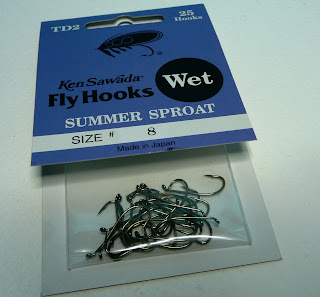For a long time now my dry sedge collection has been rather dismal and a bit embarrassing. I must admit, I tend to get by each season with an Elk-Hair caddis or a Green Peter. Although this maybe reflects my limited opportunites for fishing with sedges than anything else. Anyway, where is the fun in one or two patterns? So during Easter, with some time for the tying bench, I decided to start building up a respectable collection and returned to E J Malone's book for some assistance. Reading Malone's book is always an exploration, yet sometimes intense and tiring. The limited number of colour photo plates in the book means scrutinising the dressings very intently, hoping you have the material or in the right colour/shade and often you don't. Indeed, you can expect to deviate from the original out of prgamatism. Moreover, there is often up to three/four versions of the pattern - forcing you to think about which one to tie. Yet, this can be decided for you by material availability. Of course there is great scope to adapt these old patterns with new materials. Yet, I love the book. Besides the large range of dressings and unknown gems, Malone offers a much needed historical and fascinating insight into Irish fly dressers/dressing. Seminal!
Back to sedges - I tied some Great Red Sedges and Bann Sedges to start off with. For the wings, I coated the natural wing material in hard and nails varnish and left to dry.
Materials for above wing: Grouse Wing feather coated in hard as nails varnish

The next dressing is a variation of Martin Westbeek's (Netherlands) 'Snowshoe Caddis' as featured in his Danica fly page: http://www.danica.com/flytier/mwestbeek/snowshoe_caddis.htm. Similar to above, it is intended for fishing low in the water with a suggestion of an emerger.
Back to sedges - I tied some Great Red Sedges and Bann Sedges to start off with. For the wings, I coated the natural wing material in hard and nails varnish and left to dry.
The Bann Sedge (orange)
Hook: Fulling Mill Light dry fly hook, Size 8-10
Body: Ginger hare's ear mixed with orange seals fur
Wing: Brown hen coated in varnish
Hackle: red game cock hackle
Attenane: Cock pheasant tail cock fibres
Great Red Sedge
Hook: Fulling Mill Light dry fly hook, Size 8-10
Body: Rusty fly-rite poly yarn
Body hackle: Furnace cock hackle tied from the shank
Wing: Grouse wing (or brown hen) lightly dressed with hard as nails varnish (and dried)
Hackle: Furnance cock
Materials for above wing: Grouse Wing feather coated in hard as nails varnish

I also tied a few with the new winging material from Hemingway - purchased from Troutcatchers. Although synethic wings are something I have never bothered much with in the past, I always liked their look and decided it was it time to give them a go. They are easy to work with. You just place the folded wing over the body and tie in at the stub. For me, the problem was the rest of the fly. I tied up a great red sedge - replacing the natural feather with a synethic wing. This just looked wrong. Following others, it is advised to incorporate natural materials underside or overside the wing - such as deerhair, CDC or snowshoe hair. This sort of harmonises the fly and reduces that hard look from the wing.
Sam Anderson's Green Peter (Variant)
Body: Peacock herl
Hackle: Ginger cock (tied from back to front)
Wing 1: Hemingway brown wing
Wing 2: Natural CDC (tied in looped fashion)
Thorax: Hare's ear dubbing
Attenane: Two cock pheasant tail
Red Sedge
Body: Rust fly-rite poly yarn
Wing: Hemingway's synethic wing with dear hair before and after
Front area : grey squirrel
Snowshoe caddis (variant)
Body:Green-olive caddis flyrite poly-yarn
Underwing: grey snowshoe (teased out and down).
Wing: Hemmingway wing, with coq de leon fibres
Underwing: grey snowshoe (teased out and down).
Wing: Hemmingway wing, with coq de leon fibres
Front area: Green hare's plus dubbing

















